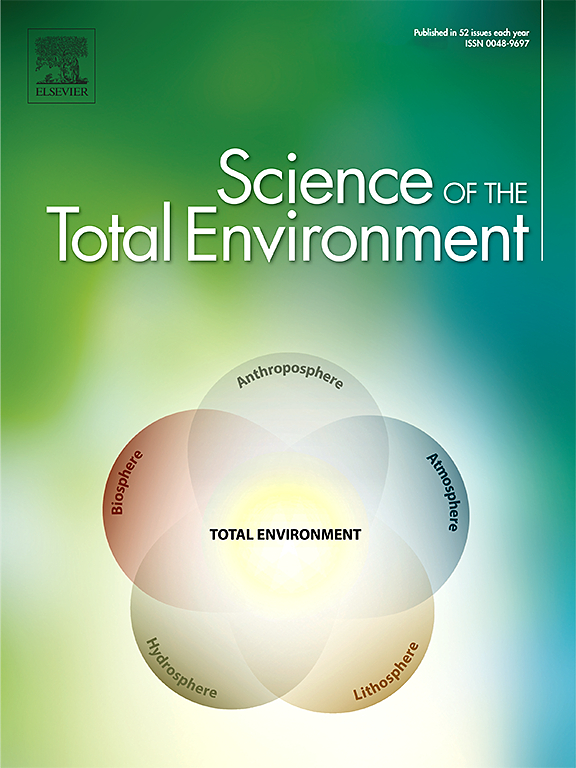加州杏仁园碳水耦合:基于涡动相关方差和遥感的生态系统水分利用效率多尺度评价
IF 8.2
1区 环境科学与生态学
Q1 ENVIRONMENTAL SCIENCES
引用次数: 0
摘要
生态系统水平的水分利用效率(WUE)是一个重要的生态生理指标,它综合了碳-水耦合过程,为水资源有限环境下的可持续农业提供了重要的见解。利用涡旋相关方差(eddy covariance, EC)与卫星遥感相结合的方法,分析了2020 - 2022年加利福尼亚杏仁果园水分利用效率的季节和年际变化特征。利用植被光合作用模型(VPM)估算总初级生产力(GPP),利用应用于Landsat影像的pySEBAL地表能量平衡模型计算蒸散量(ET)。这些通量的比值提供了WUE的空间分布估计。日GPP的变化范围为~0.5 ~ 11.5 g C m−2 d−1,而ET的变化范围为~0.5 ~ 7.5 mm d−1,两者的通量均在仲夏达到峰值。水分利用效率表现出明显的季节变化规律(范围为~0.5 ~ 5.9 g C kg−1 H2O),休眠期效率较高,果实发育期效率较低,研究期间平均为2.14 g C kg−1 H2O。GPP和ET表现出相似的季节模式,并对关键气候变量(太阳辐射、空气温度和湿度)做出响应,表明共同的环境驱动因素控制着这些过程。水分利用效率表现出更复杂的行为,在降水和湿度较大时略有增加,在高太阳辐射、高蒸汽压差(VPD)和极端温度下下降。遥感得到的GPP和ET与EC塔测量值吻合良好(R2≈0.87-0.88),证实了综合方法的可靠性。本研究促进了我们对多年生杏园系统碳水耦合的认识。它为面对日益严重的水资源短缺和气候变化的精准灌溉管理提供了有价值的生态指标。本文章由计算机程序翻译,如有差异,请以英文原文为准。

Carbon–water coupling in California almond orchards: a multi-scale assessment of ecosystem water use efficiency using eddy covariance and remote sensing
Water use efficiency (WUE) at the ecosystem level is a critical ecophysiological indicator that integrates carbon-water coupling processes and provides essential insights for sustainable agriculture in water-limited environments. This study investigated the dynamics of WUE in California almond orchards, a high-value and water-intensive crop system of global economic significance, by combining eddy covariance (EC) measurements with satellite remote sensing to analyze seasonal and interannual patterns from 2020 to 2022. Gross primary productivity (GPP) was estimated using the Vegetation Photosynthesis Model (VPM), while evapotranspiration (ET) was derived using the pySEBAL surface energy balance model applied to Landsat imagery. The ratio of these fluxes provided spatially distributed WUE estimates. Daily GPP ranged from ~0.5 to 11.5 g C m−2 d−1, while ET ranged from ~0.5 to 7.5 mm d−1, with both fluxes peaking during mid-summer. WUE values exhibited distinct seasonal patterns (ranging from ~0.5 to 5.9 g C kg−1 H2O), with higher efficiency during dormancy and lower values during fruit development stages, averaging 2.14 g C kg−1 H2O over the study period. GPP and ET showed similar seasonal patterns and responded in tandem to key climatic variables (solar radiation, air temperature, and humidity), suggesting common environmental drivers govern these processes. WUE exhibited more complex behavior: it increased slightly with greater precipitation and humidity and declined under high solar radiation, high vapor pressure deficit (VPD), and extreme temperatures. The remote sensing-derived GPP and ET agreed well with EC tower measurements (R2 ≈ 0.87–0.88), affirming the reliability of the integrated approach. This study advances our understanding of carbon-water coupling in perennial almond orchard systems. It provides valuable ecological indicators for precision irrigation management in the face of increasing water scarcity and climate variability.
求助全文
通过发布文献求助,成功后即可免费获取论文全文。
去求助
来源期刊

Science of the Total Environment
环境科学-环境科学
CiteScore
17.60
自引率
10.20%
发文量
8726
审稿时长
2.4 months
期刊介绍:
The Science of the Total Environment is an international journal dedicated to scientific research on the environment and its interaction with humanity. It covers a wide range of disciplines and seeks to publish innovative, hypothesis-driven, and impactful research that explores the entire environment, including the atmosphere, lithosphere, hydrosphere, biosphere, and anthroposphere.
The journal's updated Aims & Scope emphasizes the importance of interdisciplinary environmental research with broad impact. Priority is given to studies that advance fundamental understanding and explore the interconnectedness of multiple environmental spheres. Field studies are preferred, while laboratory experiments must demonstrate significant methodological advancements or mechanistic insights with direct relevance to the environment.
 求助内容:
求助内容: 应助结果提醒方式:
应助结果提醒方式:


